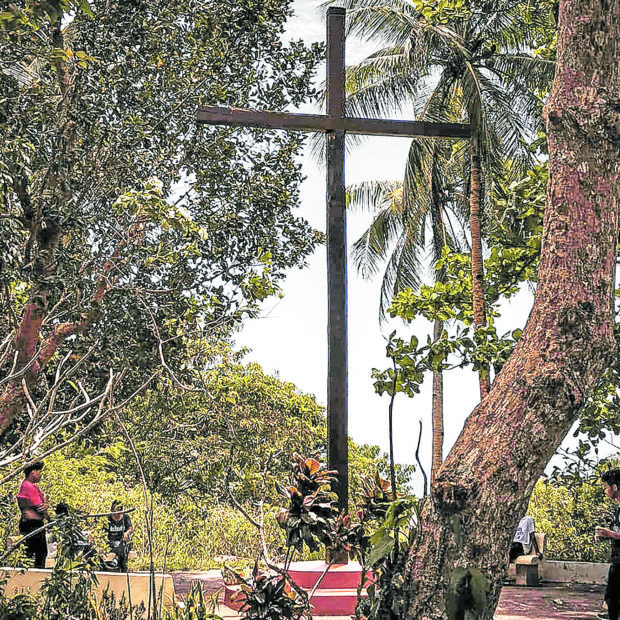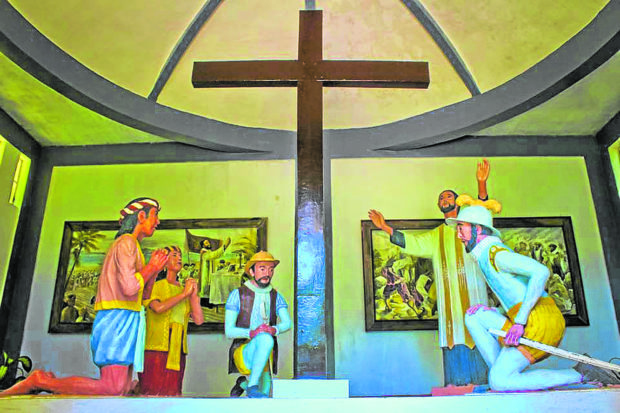Limasawa: Christianity’s cradle in PH and entire Asia

SYMBOL OF FAITH A replica of the two-story-high cross planted by Portuguese explorer Ferdinand Magellan in 1521 is considered by residents of Limasawa Island as not just a symbol of the birth of Christianity in the country but also their protector during times of calamities. —FRIAM ONG GALEZONGA/CONTRIBUTOR
Limasawa may be the smallest and poorest town in Southern Leyte province, but its residents are not fretting because they consider their island as the most blessed.
“Among all the thousands of islands, Limasawa is considered the cradle of Christianity not only in the country but in the entire Asia because it is the site of the first Mass,” said resident Merluna Tolentino.
Indeed, the about 6,000 residents of Limasawa (sixth class municipality with annual income of not more than P15 million) are proud of their town’s place in history.
On March 31, the town will host the celebration of the 500th anniversary of the first Mass held on Philippine soil by Fr. Pedro de Valderrama, the chaplain of the Spanish fleet led by Portuguese explorer Ferdinand Magellan.
Archbishop Charles John Brown, Apostolic Nuncio to the Philippines, will represent Pope Francis during the event to be held at the Magellan Shrine in Barangay Magallanes here. President Duterte will be represented by Carl Caesar Rimando, Department of the Interior and Local Government director for Eastern Visayas.
Only 500 people, including Catholic bishops and government officials, are allowed to attend the Mass due to restrictions caused by the COVID-19 pandemic.

EASTER CELEBRATION A tableau depicting the first Mass officiated by Fr. Pedro de Valderrama, chaplain of the Spanish fleet, on Easter Sunday on March 31, 1521, is built at Magellan Shrine as a reminder of the important role of Limasawa Island in the history of the Philippines and the Catholic Church in the country. —PHOTO COURTESY OF THE DEPARTMENT OF TOURISMIN EASTERN VISAYAS
Magellan’s Cross
The first Mass in the country was held on an Easter Sunday, on March 31, 1521, at the western side of the island, then called Mazaua.
Magellan planted a cross in what is now known as Barangay Triana but this was burned in 1565, apparently in protest of the arrival of the Spaniards led by Miguel Lopez de Legazpi, said local historian, Dr. Rolando Borrinaga.
Former first lady Imelda Marcos built a replica of the cross on top of a hill in Barangay Magallanes as part of her campaign to promote tourist spots in the country in the early 1980s.A set of 450 steps leads up to the commemorative 6.09-meter (20 feet) Magellan’s Cross.
According to Tolentino, the cross is not only a reminder of the country’s first Mass but it serves as the people’s protector.
“While we were not totally spared from calamities like typhoons and [other] disasters, like the COVID-19 pandemic, their impact was lesser compared to other areas,” the 49-year-old mother of four said.
Since the pandemic started over a year ago, Limasawa recorded only three cases of COVID-19.
“[We believe] the cross protects us. It is the place where we go to pray and ask help from God, aside from going to church,” she said.
While Limasawa is the site of the first Mass, other religious denominations also thrive on the island.
The Philippine Statistics Authority’s 2015 data showed that members of other religious groups outnumbered the Catholics in Limasawa. That data showed that at least 2,237 residents were Roman Catholics while 3,824 belong to other churches, including the Aglipayan Church or the Philippine Independent Church.
Borrinaga, who helped establish Limasawa as the official site of the first Mass, said the first non-Catholic religion on the island was the Aglipayan, which spread here at the start of the 20th century from the town of Padre Burgos, where Limasawa used to belong before the island became a town in 1989.
Borrinaga said Roman Catholicism returned to Limasawa in 1958 when a Catholic mission was established on the island.
Still, missionaries of other religions came to Limasawa to convert the islanders.
Aside from the Aglipayan, other non-Catholic denominations in Limasawa are the National Council of Churches in the Philippines, Iglesia ni Cristo, Seventh Day Adventist and Jehovah’s Witness.
Thus, it is not surprising to see churches of different religious denominations stand close to each other on the 698-hectare island.
But everyone is welcome in Limasawa, regardless of religion, said Fr. Johnrey Sibi, head of the Limasawa commission of the Diocese of Maasin.
“There is no competition or conflict [with other religious denominations]. We welcome them to join the 500 years celebration of Christianity here in Limasawa,” he said.
Mayor Melchor Petracorta, a Catholic, said these religions thrive in Limasawa because of the nature of its people—welcoming and accommodating.
“But there is no quarrel here among our people when it comes to religious belief. We live peacefully and we coexist. We respect one’s religion and we almost have a zero crime rate,” he added.
Public school teacher Sunny Tolaytay, an Aglipayan, said he would join the island’s celebration on March 31.
“I have several friends who are Roman Catholics and I am also proud that it is here in Limasawa where the first Catholic Mass in the country was celebrated 500 years ago,” he said.
Simple celebration
According to Mayor Petracorta, the celebration will be kept simple due to health and travel restrictions as the country deals with the health crisis.
“What is important is we celebrate the 500th year of the first Mass here in Limasawa,” he said.
Archbishop Brown will lead the Eucharistic celebration at the Magellan Shrine at 10 a.m. on March 31.
Among the concelebrants are Maasin Bishop Precioso Cantillas and Palo Archbishop John Du.
Before the Eucharistic Mass, Brown and the other bishops will enthrone the image of the Santo Niño de Limasawa and bless the “retablo,” or a devotional framework in a church located in Barangay Triana.
Fr. Mark Vincent Salang of the Diocese of Maasin said the novena Masses for the celebration started on March 21 and would end on March 30. Only 300 pilgrims had been allowed to join each Mass, held outdoors in front of Magellan’s Cross as part of precautions against the spread of COVID-19.
According to health and security guidelines issued by the Municipal Inter-Agency Task Force on COVID-19 on March 19, no one will be allowed to leave or enter Limasawa from March 22 to March 31 unless it is to respond to an emergency.
Only pilgrims, who were earlier enlisted by their respective parishes, will be allowed to enter the historic island.
Fishermen will not also be allowed to sail from midnight of March 30 to 5 p.m. the following day.
Hope on tourism
The tadpole-shaped town can be reached by sea from Padre Burgos town in under an hour.
Aside from being a pilgrimage site, Limasawa’s beaches and diving spots are considered among the best in the country.
In 1994, then President Fidel V. Ramos declared Limasawa a tourist zone.
Fishing is the main source of livelihood while many residents are beneficiaries of the government’s conditional cash grants under the Pantawid Pamilyang Pilipino Program.
Limasawa officials are hoping that the quincentennial celebration will boost the island’s tourism industry and improve the lives of its people.